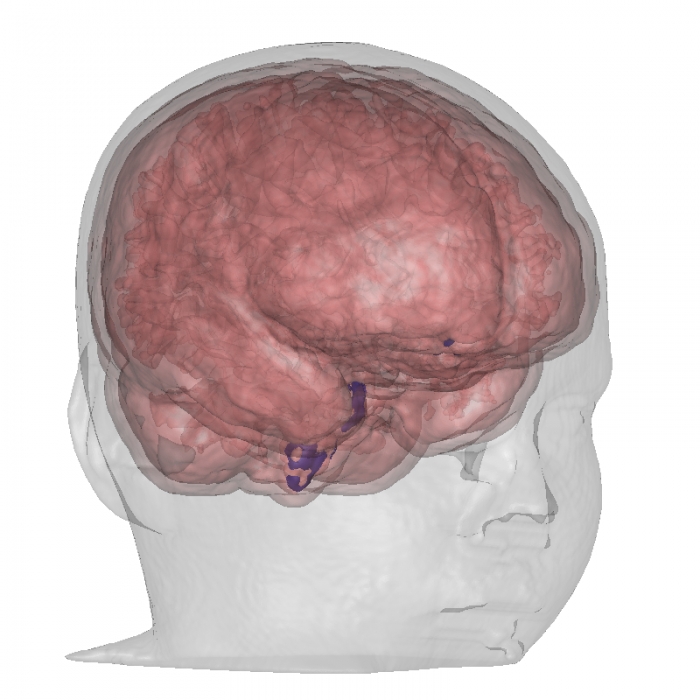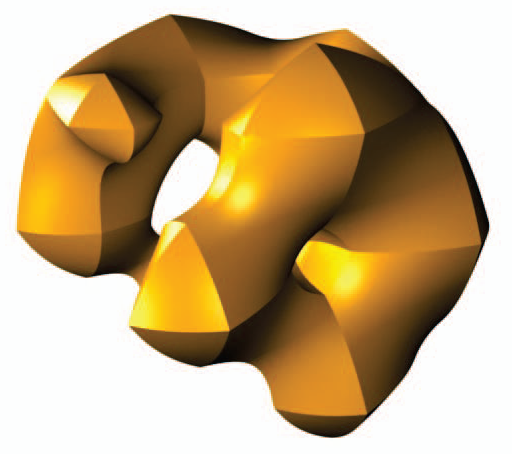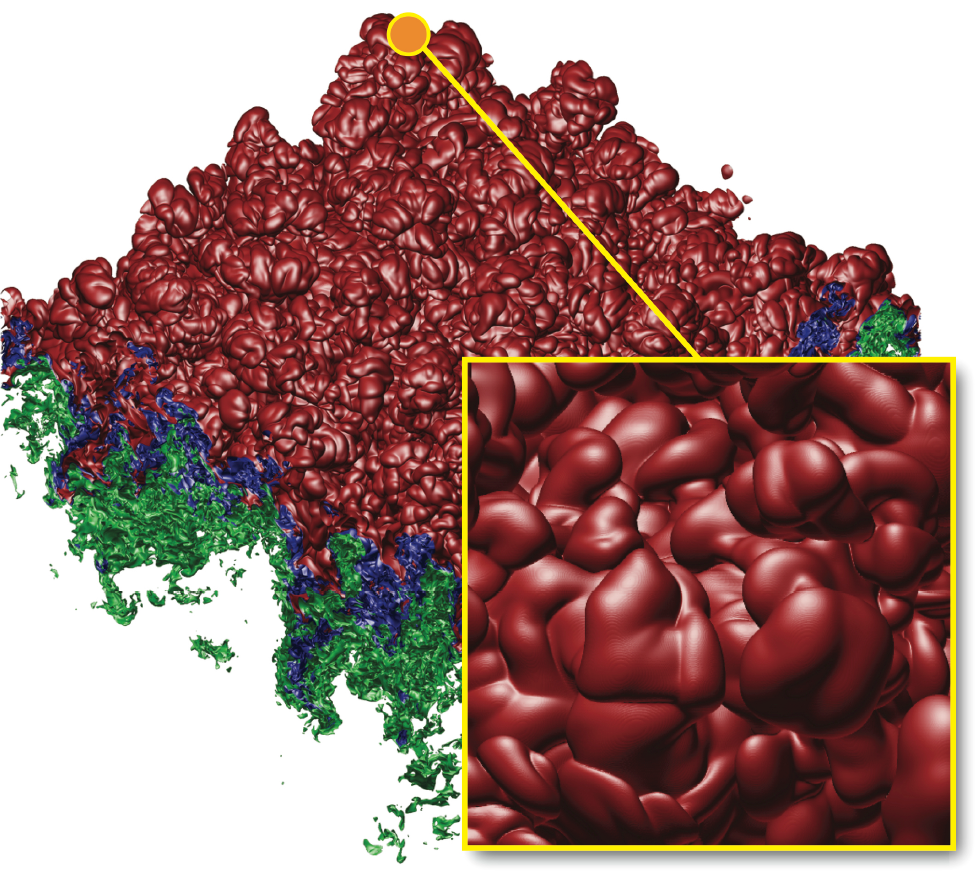SCI Publications
2021


A. Venkat, A. Gyulassy, G. Kosiba, A. Maiti, H. Reinstein, R. Gee, P.-T. Bremer, V. Pascucci.
“Towards replacing physical testing of granular materials with a Topology-based Model,” Subtitled “arXiv preprint arXiv:2109.08777,” 2021.
In the study of packed granular materials, the performance of a sample (e.g., the detonation of a high-energy explosive) often correlates to measurements of a fluid flowing through it. The "effective surface area," the surface area accessible to the airflow, is typically measured using a permeametry apparatus that relates the flow conductance to the permeable surface area via the Carman-Kozeny equation. This equation allows calculating the flow rate of a fluid flowing through the granules packed in the sample for a given pressure drop. However, Carman-Kozeny makes inherent assumptions about tunnel shapes and flow paths that may not accurately hold in situations where the particles possess a wide distribution in shapes, sizes, and aspect ratios, as is true with many powdered systems of technological and commercial interest. To address this challenge, we replicate these measurements virtually on micro-CT images of the powdered material, introducing a new Pore Network Model based on the skeleton of the Morse-Smale complex. Pores are identified as basins of the complex, their incidence encodes adjacency, and the conductivity of the capillary between them is computed from the cross-section at their interface. We build and solve a resistive network to compute an approximate laminar fluid flow through the pore structure. We provide two means of estimating flow-permeable surface area: (i) by direct computation of conductivity, and (ii) by identifying dead-ends in the flow coupled with isosurface extraction and the application of the Carman-Kozeny equation, with the aim of establishing consistency over a range of particle shapes, sizes, porosity levels, and void distribution patterns.
2015


M. Kim, C.D. Hansen.
“GPU Surface Extraction with the Closest Point Embedding,” In Proceedings of IS&T/SPIE Visualization and Data Analysis, 2015, February, 2015.
Isosurface extraction is a fundamental technique used for both surface reconstruction and mesh generation. One method to extract well-formed isosurfaces is a particle system; unfortunately, particle systems can be slow. In this paper, we introduce an enhanced parallel particle system that uses the closest point embedding as the surface representation to speedup the particle system for isosurface extraction. The closest point embedding is used in the Closest Point Method (CPM), a technique that uses a standard three dimensional numerical PDE solver on two dimensional embedded surfaces. To fully take advantage of the closest point embedding, it is coupled with a Barnes-Hut tree code on the GPU. This new technique produces well-formed, conformal unstructured triangular and tetrahedral meshes from labeled multi-material volume datasets. Further, this new parallel implementation of the particle system is faster than any known methods for conformal multi-material mesh extraction. The resulting speed-ups gained in this implementation can reduce the time from labeled data to mesh from hours to minutes and benefits users, such as bioengineers, who employ triangular and tetrahedral meshes.
Keywords: scalar field methods, GPGPU, curvature based, scientific visualization
2011


T. Etiene, L.G. Nonato, C. Scheidegger, J. Tierny, T.J. Peters, V. Pascucci, R.M. Kirby, C.T. Silva.
“Topology Verfication for Isosurface Extraction,” In IEEE Transactions on Visualization and Computer Graphics, pp. (accepted). 2011.
The broad goals of verifiable visualization rely on correct algorithmic implementations. We extend a framework for verification of isosurfacing implementations to check topological properties. Specifically, we use stratified Morse theory and digital topology to design algorithms which verify topological invariants. Our extended framework reveals unexpected behavior and coding mistakes in popular publicly-available isosurface codes.


H.T. Vo, J. Bronson, B. Summa, J.L.D. Comba, J. Freire, B. Howe, V. Pascucci, C.T. Silva.
“Parallel Visualization on Large Clusters using MapReduce,” In Proceedings of the 2011 IEEE Symposium on Large-Scale Data Analysis and Visualization (LDAV), pp. 81--88. 2011.
Large-scale visualization systems are typically designed to efficiently \"push\" datasets through the graphics hardware. However, exploratory visualization systems are increasingly expected to support scalable data manipulation, restructuring, and querying capabilities in addition to core visualization algorithms. We posit that new emerging abstractions for parallel data processing, in particular computing clouds, can be leveraged to support large-scale data exploration through visualization. In this paper, we take a first step in evaluating the suitability of the MapReduce framework to implement large-scale visualization techniques. MapReduce is a lightweight, scalable, general-purpose parallel data processing framework increasingly popular in the context of cloud computing. Specifically, we implement and evaluate a representative suite of visualization tasks (mesh rendering, isosurface extraction, and mesh simplification) as MapReduce programs, and report quantitative performance results applying these algorithms to realistic datasets. For example, we perform isosurface extraction of up to l6 isovalues for volumes composed of 27 billion voxels, simplification of meshes with 30GBs of data and subsequent rendering with image resolutions up to 800002 pixels. Our results indicate that the parallel scalability, ease of use, ease of access to computing resources, and fault-tolerance of MapReduce offer a promising foundation for a combined data manipulation and data visualization system deployed in a public cloud or a local commodity cluster.
Keywords: MapReduce, Hadoop, cloud computing, large meshes, volume rendering, gigapixels
2010


T. Etiene, L.G. Nonato, C.E. Scheidegger, J. Tierny, T.J. Peters, V. Pascucci, R.M. Kirby, C.T. Silva.
“Topology Verification for Isosurface Extraction,” SCI Technical Report, No. UUSCI-2010-003, SCI Institute, University of Utah, 2010.


C.E. Scheidegger, T. Etiene, L.G. Nonato, C.T. Silva.
“Edge Flows: Stratified Morse Theory for Simple, Correct Isosurface Extraction,” SCI Technical Report, No. UUSCI-2010-002, SCI Institute, University of Utah, 2010.
2009


T. Etiene, C.E. Scheidegger, L.G. Nonato, R. Kirby, C.T. Silva.
“Verifiable Visualization for Isosurface Extraction,” In IEEE Transactions on Visualization and Computer Graphics, Proceedings of the 2009 IEEE Visualization Conference, Vol. 15, No. 6, pp. 1227--1234. Sept/Oct, 2009.
2008


Y. Livnat, S.G. Parker, C.R. Johnson.
“Fast Isosurface Extraction Methods for Large Image Data Sets,” In Handbook of Medical Image Processing and Analysis, 2nd edition, Ch. 47, Note: (to appear), Edited by Isaac N. Bankman, Elsevier, pp. 801--816. 2008.
2007


Y. Livnat, S.G. Parker, C.R. Johnson.
“Fast Isosurface Extraction Methods for Large Image Data Sets,” In Handbook of Medical Imaging: Processing and Analysis, 2nd Edition, Ch. 44, Edited by Isaac Bankman, Academic Press, 2007.
2005

C.D. Hansen, C.R. Johnson.
“The Visualization Handbook,” Elsevier, 2005.
ISBN: 0-12-387582-X


Y. Livnat.
“Accelerated Isosurface Extraction Approaches,” In The Visualization Handbook, Edited by C.D. Hansen and C.R. Johnson, Elsevier, pp. 39--55. 2005.
ISBN: 0-12-387582-X


Y. Livnat, X. Tricoche.
“Shadows for Incomplete Point-based Isosurfaces,” SCI Institute Technical Report, No. UUSCI-2005-001, University of Utah, 2005.


R.T. Whitaker.
“Isosurfaces and Level-Sets,” In The Visualization Handbook, Edited by C.D. Hansen and C.R. Johnson, Elsevier, pp. 97--123. 2005.
ISBN: 0-12-387582-X
2004


Y. Livnat, X. Tricoche.
“Interactive Point Based Isosurface Extraction,” In Proceeding of IEEE Visualization 2004, pp. 457--464. 2004.

A. Mascarenhas, M. Isenburg, V. Pascucci, J. Snoeyink.
“Encoding Volumetric Meshes For Streaming Isosurface Extraction,” In Proceedings of the International Symposium on 3D Data Processing, Visualization, and Transmission (3DPVT), Note: UCRL-PROC-208696, pp. 293--300. September, 2004.
2003


Y. Livnat, C.D. Hansen.
“Dynamic View Dependent Isosurface Extraction,” SCI Institute Technical Report, No. UUSCI-2003-004, University of Utah, 2003.
2002


Y. Livnat, X. Cavin, C.D. Hansen.
“PHASE: Progressive Hardware Assisted IsoSurface Extraction Framework,” SCI Institute Technical Report, No. UUSCI-2002-001, University of Utah, 2002.
2001


Y. Livnat, C.D. Hansen, S.G. Parker, C.R. Johnson.
“Isosurface extraction for large-scale datasets,” In Proceedings of Scientific Visualization -Dagstuhl`2000, Edited by F. Post, 2001.
2000




Y. Livnat, S.G. Parker, C.R. Johnson.
“Fast Isosurface Extraction Methods for Large Image Data Sets,” In Handbook of Medical Imaging, Edited by A.N. Bankman, Academic Press, San Diego, CA pp. 731--745. Nov, 2000.


P. Sutton, C.D. Hansen.
“Accelerated Isosurface Extraction in Time-varying Fields,” In IEEE Trans. Vis & Comp. Graph., Vol. 6, No. 2, pp. 98--107. 2000.







